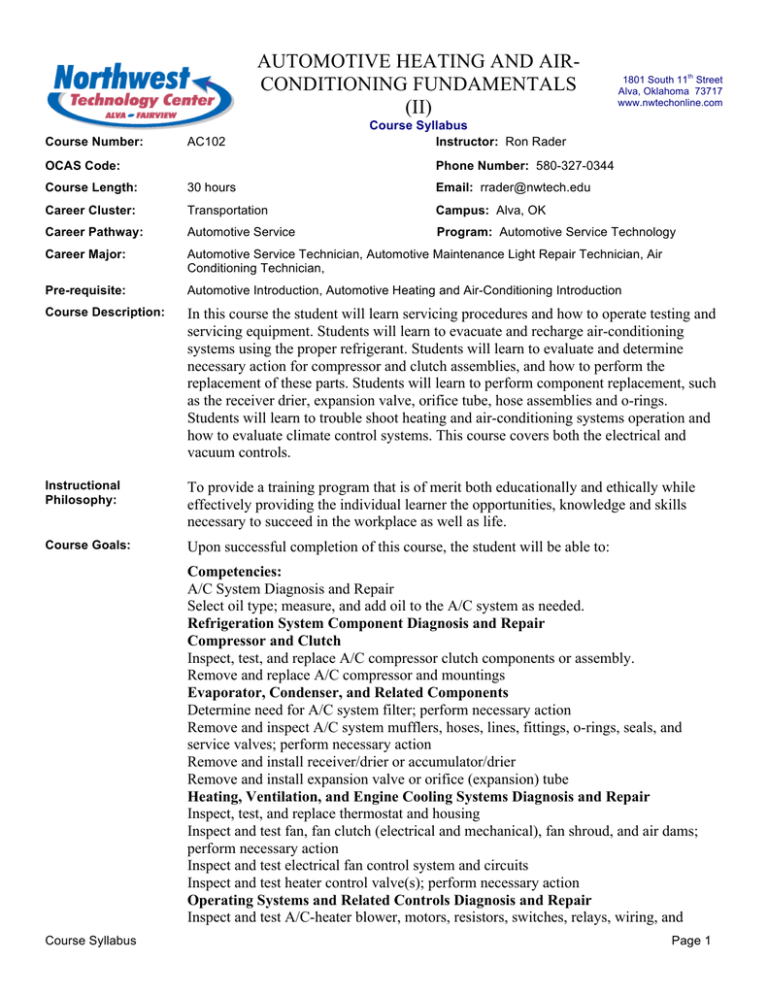automotive heating and air- conditioning fundamentals (ii)
advertisement

AUTOMOTIVE HEATING AND AIRCONDITIONING FUNDAMENTALS (II) Course Number: AC102 OCAS Code: th 1801 South 11 Street Alva, Oklahoma 73717 www.nwtechonline.com Course Syllabus Instructor: Ron Rader Phone Number: 580-327-0344 Course Length: 30 hours Email: rrader@nwtech.edu Career Cluster: Transportation Campus: Alva, OK Career Pathway: Automotive Service Program: Automotive Service Technology Career Major: Automotive Service Technician, Automotive Maintenance Light Repair Technician, Air Conditioning Technician, Pre-requisite: Automotive Introduction, Automotive Heating and Air-Conditioning Introduction Course Description: In this course the student will learn servicing procedures and how to operate testing and servicing equipment. Students will learn to evacuate and recharge air-conditioning systems using the proper refrigerant. Students will learn to evaluate and determine necessary action for compressor and clutch assemblies, and how to perform the replacement of these parts. Students will learn to perform component replacement, such as the receiver drier, expansion valve, orifice tube, hose assemblies and o-rings. Students will learn to trouble shoot heating and air-conditioning systems operation and how to evaluate climate control systems. This course covers both the electrical and vacuum controls. Instructional Philosophy: To provide a training program that is of merit both educationally and ethically while effectively providing the individual learner the opportunities, knowledge and skills necessary to succeed in the workplace as well as life. Course Goals: Upon successful completion of this course, the student will be able to: Competencies: A/C System Diagnosis and Repair Select oil type; measure, and add oil to the A/C system as needed. Refrigeration System Component Diagnosis and Repair Compressor and Clutch Inspect, test, and replace A/C compressor clutch components or assembly. Remove and replace A/C compressor and mountings Evaporator, Condenser, and Related Components Determine need for A/C system filter; perform necessary action Remove and inspect A/C system mufflers, hoses, lines, fittings, o-rings, seals, and service valves; perform necessary action Remove and install receiver/drier or accumulator/drier Remove and install expansion valve or orifice (expansion) tube Heating, Ventilation, and Engine Cooling Systems Diagnosis and Repair Inspect, test, and replace thermostat and housing Inspect and test fan, fan clutch (electrical and mechanical), fan shroud, and air dams; perform necessary action Inspect and test electrical fan control system and circuits Inspect and test heater control valve(s); perform necessary action Operating Systems and Related Controls Diagnosis and Repair Inspect and test A/C-heater blower, motors, resistors, switches, relays, wiring, and Course Syllabus Page 1 protection devices; perform necessary action Refrigerant Recovery, Recycling, and Handling Verify correct operation and maintenance of refrigerant handling equipment Identify (by label application or use of a refrigerant identifier) and recover A/C system refrigerant Recycle refrigerant Label and store refrigerant Test recycled refrigerant for non-condensable gases Evacuate and charge A/C system Major Course Projects: Project Outline: Students will perform tasks relating to the Automotive Service Industry as per standards identified by the National Automotive Technicians Education Foundation (NATEF). Students will complete repair orders each day and will document completion of competencies on competency profiles tracking individual progress and accomplishment. Projects will include performing tasks on mock ups, shop vehicles, and live work as student skills progress. These projects will reinforce classroom theory instruction and will require the student to consult industry service information during the course of task performance. Instructional Delivery Plan: The instruction for this course will be comprised of multiple methods designed to promote and accommodate different learning styles including classroom lecture, classroom demonstrations, shop demonstrations, hands on learning activities, classroom discussion, interactive media, textbook, computer based learning activities, research projects, guest speakers, student presentations, and interactive learning with CPS (Classroom Performance System). Students will be required to practice the skills associated with the instructional content and will be required to work independently and also in teams. Assignments will require students to use academic skills in math, science, and language arts. Assessment Plan: Students will be assessed according to three basic kinds of learning. Knowledge: Does the student possess the required knowledge to perform a specific competency? Skills: Does the student possess the necessary coordination to perform the task/competency? Attitude: Will the student perform the task/competency on the job after learning to do it? Students will also be assessed according to the basic work skills of attendance and promptness. Soft skills will be assessed in the Academic Career Center. 50% 50% Alliance Credit Offered: Daily work- Performance of technical skills on job, work habits, safety, clean-up, participation Written assignment- Repair orders, textbook assignments, etc. Grading Scale: A 90-100 Exceeds expectations B 80-89 Meets industry standards and expectations C 70-79 Passing grade, but does not meet some standards D 60-69 Passing, but only meets the minimum standards F Below 60 Failing, does not meet minimum standards OSU Okmulgee Industry Alignments: ASE Certification, ODCTE Certification, End of Instruction ASE Certification, ODCTE Certification, Course Syllabus Page 2 Industry Assessment: Resources: Automotive Excellence Vol. 1 and Vol. 2 Modern Automotive Technology Introduction to Automotive Service: Fundamental Concepts CDX Global Interactive Training Snap On Shop Key Alldata Attachments: See Automotive Service Technology Task List Competency Handbook Course Syllabus Page 3